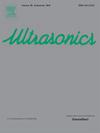基于光纤光栅应变传感器的超声导波技术在钢筋混凝土腐蚀早期检测中的应用
IF 3.8
2区 物理与天体物理
Q1 ACOUSTICS
引用次数: 0
摘要
钢筋混凝土(RC)在建筑中被广泛使用,但腐蚀,特别是在海洋环境中,带来了相当大的挑战,导致高昂的维护成本。无损腐蚀检测技术是保证结构安全的关键技术。本研究的目的是利用泄漏的UGW检测钢筋混凝土的早期腐蚀。通过实验和数值模拟,探讨了超重力波在混凝土中钢筋中的传播以及能量在混凝土介质中的泄漏。该研究还旨在使用嵌入式光纤布拉格光栅(FBG)应变传感器提供被动腐蚀监测。采用外加电压加速腐蚀装置模拟钢筋混凝土试件的自然腐蚀。结果表明,第一纵向模态L(0,1)占主导地位,其振幅对腐蚀很敏感,即使在远离腐蚀源的地方监测也是如此。通过信号强度和L(0,1)特征的变化来区分不同的腐蚀阶段(起始、进展和直径减小)。在棒材2上观察到的泄漏波受腐蚀并向相邻棒材传播,对径缩相和裂纹扩展表现出敏感性。在这一阶段,振幅的显著下降表明了这一点。此外,FBG传感器的集成提供了进一步了解应变和GW读数之间的相关性,特别是在直径减小阶段。结果表明,UGW在钢筋混凝土结构腐蚀检测与评价中的有效性。本文章由计算机程序翻译,如有差异,请以英文原文为准。
Early detection of corrosion in reinforced concrete using ultrasonic guided wave technique correlated with embedded fiber bragg grating strain sensors
Reinforced concrete (RC) is commonly utilized in construction, but corrosion, particularly in marine environments, causes considerable challenges, resulting in high maintenance costs. Non-destructive corrosion detection techniques are critical to ensure structural safety. This study aims to detect early corrosion in steel-reinforced concrete using leaking UGW. UGW propagation in steel bars embedded in concrete and energy leakage through the concrete medium were explored experimentally and numerically. The study also aims to provide passive corrosion monitoring using embedded Fiber Bragg Gratings (FBG) strain sensors. An accelerated corrosion setup using the impressed voltage technique was employed to simulate natural corrosion in RC specimens. The results reveal that the first longitudinal mode, L(0,1), is dominant and its amplitude is sensitive to corrosion, even when monitored away from the corrosion source. Different corrosion stages (initiation, progression, and diameter reduction) were distinguished by variations in signal strength and L(0,1) characteristics. The leaky wave observed from bar 2, which was subjected to corrosion and propagated to neighboring bars, showed sensitivity to the diameter reduction phase and crack propagation. This was indicated by a significant drop in amplitude during that phase. Additionally, the integration of FBG sensors provided further insights into the correlation between strain and GW readings, particularly during the diameter reduction phase. The results demonstrate the effectiveness of UGW for the detection and assessment of corrosion in steel-reinforced concrete structures.
求助全文
通过发布文献求助,成功后即可免费获取论文全文。
去求助
来源期刊

Ultrasonics
医学-核医学
CiteScore
7.60
自引率
19.00%
发文量
186
审稿时长
3.9 months
期刊介绍:
Ultrasonics is the only internationally established journal which covers the entire field of ultrasound research and technology and all its many applications. Ultrasonics contains a variety of sections to keep readers fully informed and up-to-date on the whole spectrum of research and development throughout the world. Ultrasonics publishes papers of exceptional quality and of relevance to both academia and industry. Manuscripts in which ultrasonics is a central issue and not simply an incidental tool or minor issue, are welcomed.
As well as top quality original research papers and review articles by world renowned experts, Ultrasonics also regularly features short communications, a calendar of forthcoming events and special issues dedicated to topical subjects.
 求助内容:
求助内容: 应助结果提醒方式:
应助结果提醒方式:


